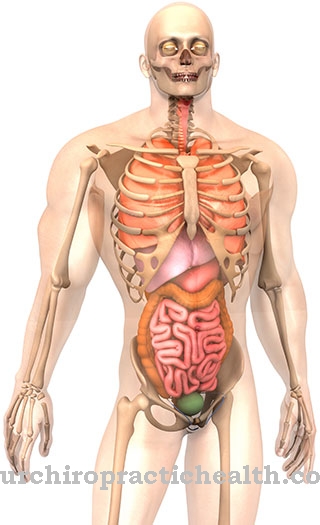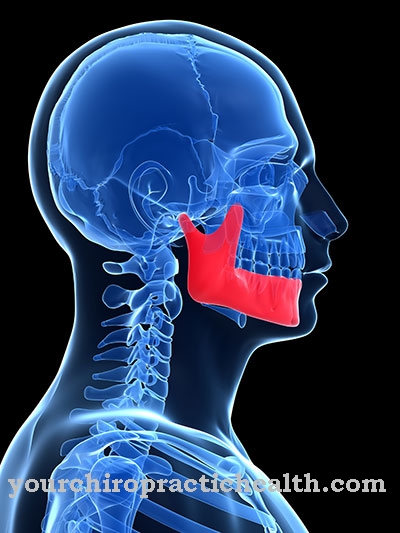Epilepsy is a feature of various brain diseases. It manifests itself in seizures and becomes the most common form of these seizures Grand mal seizure (great attack) called.
What is a grand mal seizure?

© sudok1 - stock.adobe.com
The word "epilepsy" comes from ancient Greek, "epilepsis" means attack or attack. This illustrates how suddenly and unpredictably such a seizure can happen in the brain and put those affected out of action. Science distinguishes different forms of seizures.
They differ, on the one hand, in the region of the brain in which they originate and, on the other hand, in their strength. There are convulsions with no or very brief impairment of consciousness (petit mal seizures), with and without twitching of the extremities and tonic-clonic seizures with deep unconsciousness, spasms and strong convulsions - the grand mal seizures.
causes
The causes of epilepsy vary widely. Brain damage, for example due to a lack of oxygen during birth, is just as possible as malformations of the brain tissue or blood vessels. But also infectious diseases, inflammatory processes in the brain, poisoning, drug consumption, electric shocks and various metabolic disorders can trigger epilepsy.
With a certain inclination, there are sometimes very banal triggers, for example twitching lights in a disco, loud noises. Excitement, sleep deprivation, or breathing too quickly. Sometimes, however, the attending physicians cannot find any clues about the sudden discharges in the brain that lead to various types of seizures.
Symptoms, ailments & signs
As a rule, the grand mal seizure proceeds as follows: In the first phase, those affected feel a kind of anticipation, a special malaise. Experts call this an aura. In the second, the tonic phase, they completely lose control of themselves, completely stiffen and pass out. If it is no longer possible to lie down, many people fall and can seriously injure themselves.
In the clonic phase that follows, there is uncontrollable twitching of the arms and legs, and some affected people also bite their lips and tongue with blood. In the subsequent recovery phase, those affected are in a kind of deep sleep. The entire grand mal seizure can last a few seconds, a few minutes or hours.
Those affected cannot influence the seizure process or the duration of the seizure in any way. But relatives, friends or people who happen to be present can help with a grand mal seizure. The possibilities to help are limited. Rescuers can only try to ensure that the patient does not fall as hard as possible and that the twitching that occurs does not bump into obstacles and objects and injure them in the process.
You should also make sure that he gets enough air during the recovery phase. Therefore it may be necessary to put him in a stable side position. Anyone who experiences a grand mal seizure in someone they do not know should always call an emergency doctor as a precaution. Relatives can assess whether this is necessary or whether it is sufficient to wait for the seizure to end.
There are also some emergency medications that work for long-lasting seizures and that relatives can give to those affected if they have been instructed to do so by the treating doctor. Under no circumstances should those affected be left alone in this completely helpless situation.
diagnosis
To diagnose epilepsy, the seizure picture must be carefully analyzed. The information provided by witnesses who witnessed it is also important, because the person concerned usually does not notice the attack. Magnetic resonance imaging (MRI) is also required.
The doctor can use it to determine whether there is a structural change in the brain.Computed tomography and electroencephalography may also be necessary, and in special cases also magnetic resonance imaging, angiography and cerebral fluid puncture.
Complications
The grand mal seizure leads to an epileptic seizure. This can result in extreme consequential damage and complications for the patient. These depend to a large extent on the respective situation and the patient's well-being.
Usually there is a feeling of malaise before the attack and a continued loss of control. The affected person stiffens and in most cases can no longer move. Shortly thereafter, it faints. Loss of consciousness can result in a fall or a blow, with various complications.
These can also occur if the person concerned is driving a vehicle or working on a dangerous machine at the time of the grand mal seizure. The grand mal seizure cannot be treated itself, so the patient can only be brought into a stable position. In addition, people around you can hold the patient in the event of a fall so that there are no injuries.
There are usually no complications. Furthermore, the epileptic seizures are limited in time, although no precise prediction can be made as to when the next seizure will occur.
When should you go to the doctor?
A grand mal seizure is an epileptic seizure in which the affected person loses control of their own body. However, this clinical picture can occur in different degrees of severity, so that direct medical treatment is not always necessary.
Mild and initial seizures are usually felt as a simple muscle twitch. Immediate treatment by a doctor is not necessary in such a case. However, the uncontrolled muscle twitching should still be observed so that there are no further complications or complaints.
If the epileptic seizures lead to a total loss of control, then a visit to the doctor should not be postponed. In such a case, drug treatment is absolutely necessary to prevent serious consequential damage.
In addition, a serious underlying disease can only be diagnosed or excluded in this way. So the following applies: A grand mal seizure is a serious clinical picture that should definitely be treated by a doctor. Only if the person concerned consults a doctor as quickly as possible can possible complications and aggravations be avoided.
Doctors & therapists in your area
Treatment & Therapy
In the case of epilepsy, one cannot really speak of a cure. However, according to detailed studies, between 50 and around 80 percent of all those affected achieve complete freedom from seizures or at least many years of freedom from seizures. It is not possible to predict with certainty whether the epilepsy will go away again; too little is known about the triggers for that.
Nevertheless, both those affected and their doctors can do a lot to reduce the frequency of epileptic seizures, and sometimes to make them go away completely. Refraining from drugs and alcohol, getting enough sleep, learning relaxation techniques, a certain type of diet, and generally a healthy lifestyle can be helpful.
Doctors can also initiate drug therapy. There are several types of so-called seizure blockers today. However, their effect is imprecise and some of them have very unpleasant side effects. Such medication must therefore be carried out with a precise risk / benefit assessment and the most precise dosage.
In the case of very frequent and long-lasting seizures and a very severe impairment of the quality of life, there may also be the possibility of electrical stimulation of the vagus nerve. He continues to suffer from excitations in the brain and can thus alleviate certain types of seizures or at least reduce their frequency.
In some cases there is also the option of surgery. But this is only possible if there is brain or vascular damage that can be precisely localized. In addition, such an operation is very risky.
Outlook & forecast
The prognosis of a grand mal seizure depends on the circumstances and the environment in which it occurs. Therefore, various complications can arise, which in the worst case can lead to death. The risk of falling with subsequent serious physical injuries in the form of broken bones is increased.
Seizures during pregnancy are dangerous for both mother and child, and certain anti-epileptic drugs increase the risk of birth defects. People with grand mal seizures are more likely to have psychological problems such as depression and anxiety. These problems can also be the result of complications related to the condition itself as well as drug side effects.
The earlier medical treatment is initiated, the more favorable the prognosis. The shorter the time between the first attack and adequate drug treatment, the better the prognosis. The division made here with its subgroups is just as decisive. Children between the ages of one and fourteen show the best chance of success in almost complete rehabilitation.
Here, too, the classification of the different grades and the frequency of the seizures are important. Mere mental absences, called absences, completely disappear as we grow up. The relapse rate in children with grand mal seizures is around 12%, provided they are at least three years old.
prevention
Epilepsy and especially the occurrence of grand mal seizures is a serious condition and can significantly reduce the quality of life of those affected. But it is not a fatal disease and with the necessary knowledge and support and understanding of the environment one can live with it relatively normally.
Aftercare
After the first grand mal attack, intensive follow-up care is absolutely essential. As soon as the medical first aid has been completed and the condition of the person concerned has stabilized, intensive examinations for a precise diagnosis of epilepsy are necessary. These can sometimes last several days and are usually associated with inpatient hospital stays.
Lifelong follow-up is necessary to adjust to optimal drug treatment of the underlying form of epilepsy. First, the check-ups are carried out several times a month at very short intervals. Over time, depending on the success of the drug therapy, they usually become rarer.
If further grand mal seizures or other physical complaints occur, even more intensive follow-up care is necessary. In general, it is advisable to attend all follow-up and check-ups. In addition, to be on the safe side, further examinations can be carried out if the person concerned so wishes.
If the patient remains seizure-free for a longer period of time, the intervals for medical checks can be reduced. However, this must be clarified with the treating doctor. For those affected with a known diagnosis of epilepsy who have repeatedly suffered a grand mal seizure, several medical check-ups are also advisable after initial medical care.
You can do that yourself
The disruption of both hemispheres of the brain causes generalized seizures in epileptics. The development phase is accompanied by harbingers of an attack. The patient is irritable, disgruntled and has headaches. Other physical signs include tingling in the hands and legs and impaired hearing.
The perception and classification of the symptoms is important for epileptics. The triggering of a grand mal seizure is individual for each patient. The seizure self-monitoring provides the patient with information about the course of their own illness. Epileptics who actively deal with their illness learn to avoid seizure situations. Stress is known as a recurring seizure trigger.
Recognizing it as a trigger makes it possible to take effective countermeasures. Active relaxation exercises break the progression to the run-up. Seizure self-control can be learned and is carried out over a longer period of time. The duration of the attacks depends on the rhythm. A good body awareness is a prerequisite. Self-observation is a supplement to drug treatment.
Communication with the social environment is important for chronic epileptics. A grand mal seizure is difficult for relatives to assess and is terrifying. Information about the stages of a seizure and what action to take will help those affected.


.jpg)






















.jpg)


